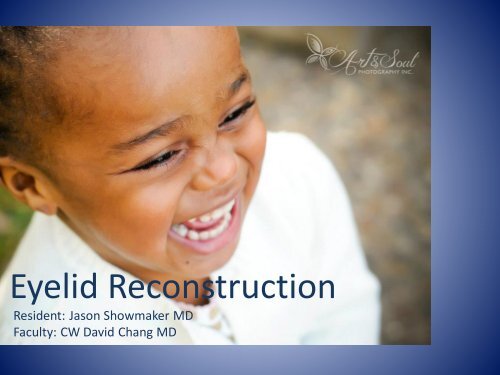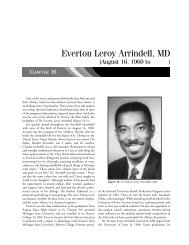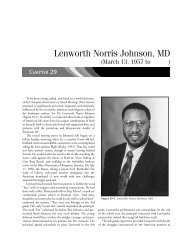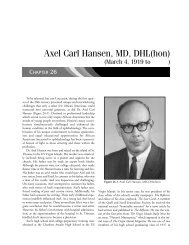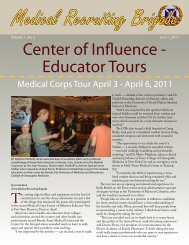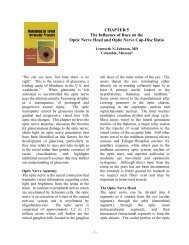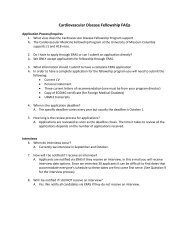GR Eyelid Reconstruction
GR Eyelid Reconstruction
GR Eyelid Reconstruction
Create successful ePaper yourself
Turn your PDF publications into a flip-book with our unique Google optimized e-Paper software.
<strong>Eyelid</strong> <strong>Reconstruction</strong><br />
Resident: Jason Showmaker MD<br />
Faculty: CW David Chang MD
Objectives<br />
• Etiology of <strong>Eyelid</strong> Defects<br />
• Anatomy<br />
• Lower <strong>Eyelid</strong> <strong>Reconstruction</strong><br />
• Upper <strong>Eyelid</strong> <strong>Reconstruction</strong><br />
• Reconstructive Techniques<br />
• Jeopardy/Quiz Bowl
• Trauma<br />
Etiology
Etiology<br />
• Excision of Cutaneous Malignancy<br />
– Basal Cell Carcinoma<br />
– Squamous Cell carcinoma<br />
– Malignant melanoma<br />
– Sebaceous carcinoma<br />
– Microcystic adnexal carcinoma
Etiology<br />
• Excision of Cutaneous Malignancy [6]<br />
– Basal Cell Carcinoma 90%<br />
– Squamous Cell carcinoma 5-10%<br />
– Malignant melanoma uncommon<br />
– Sebaceous carcinoma uncommon<br />
– Microcystic adnexal carcinoma uncommon
Mohs Cure Rates<br />
• BCC – primary 99%, recurrent 92%<br />
• SCC - primary 98%, recurrent 95%<br />
• Melanoma – MIS and thin melanoma (
Anatomy<br />
• Skin surface<br />
• Muscular anatomy<br />
• Blood supply<br />
• Tarsoligamentous Sling<br />
• Bilamellar construct<br />
• Lacrimal System
Orbicularis Oculi
Orbicularis Oculi
Vascular Supply
Bilamellar Unit<br />
• Anterior lamella<br />
– Skin and orbicularis oculi<br />
• Posterior lamella<br />
– <strong>Eyelid</strong> retractors, tarsal plate, and conjunctivae
Upper Lid Retractors
Upper <strong>Eyelid</strong> Retractors
Lid Protractors
Lacrimal Drainage System
Lacrimal Drainage System
Tear Film
<strong>Reconstruction</strong><br />
– Anterior lamella<br />
– Posterior lamella (Full thickness defects)<br />
– <strong>Eyelid</strong> Margin<br />
• Upper/Lower<br />
• Size
Goals of Lid <strong>Reconstruction</strong><br />
• Protection of eye<br />
• Adequate skin and muscle for closure/blink<br />
• Smooth epithelialized posterior lid surface<br />
• Posterior apposition of lid to globe<br />
• Stable lid margin, canthal angle, and shape<br />
• Cosmesis with minimal scars
Anterior Lamella <strong>Reconstruction</strong><br />
• Laissez faire*<br />
• Primary closure<br />
• Full Thickness Skin Grafts<br />
• O-S Plasty<br />
• Rhombic Flap<br />
• Musculocutaneous Advancement Flap<br />
• Unipedicle Advancement Flap<br />
• Transposition Flap
RSTL<br />
[5]
[5]
Skin Grafts<br />
• FTSG – preferred<br />
– Sites<br />
• Upper eyelid<br />
• Pre/post-auricular skin<br />
• Supraclavicular skin<br />
• Inner upper arm skin<br />
– Relative contraindication<br />
• Compromised vascularity of wound bed<br />
– Irradiation<br />
– Third degree burns [1]
O-S and O-Z plasty<br />
[5]
Rhombic Flaps<br />
[5]
Musculocutaneous Advancement Flap<br />
[5]
Unipedicle Advancement Flap<br />
[5]
Transposition Flap<br />
[5]
<strong>Reconstruction</strong><br />
– Anterior lamella<br />
– Posterior lamella (Full thickness defects)<br />
– <strong>Eyelid</strong> Margin<br />
• Upper/Lower<br />
• Size
Posterior Lamella <strong>Reconstruction</strong><br />
• Replacing lost conjunctiva<br />
– Buccal mucosa - preferred<br />
– Hard palate mucosa – persistent keratinization<br />
– Turbinate mucosa - loses goblet cells after transfer<br />
– Tarsoconjunctival free graft<br />
– *tarsus reconstruction with auricular or nasal<br />
septal cartilage/mucosa graft
Posterior Lamella Recon<br />
• Replacing lost tarsus<br />
– Insertion of cartilage graft<br />
• Warping<br />
• Weight<br />
• Unnecessary?<br />
– Tarsal plate histology – connective tissue with collagen, no<br />
cartilage.<br />
– *Facial nerve paralysis<br />
– Insert mucosal graft with tension and globe<br />
apposition
Posterior Lamella <strong>Reconstruction</strong><br />
• Orbicularis Oculi Defect<br />
– Greater defect tolerated in upper lid<br />
– lower lid more prone to ectropion<br />
• Canthal Ligament defect<br />
– Refixation to bone – burr holes, anchor, periosteal flap<br />
• Levator palpebrae defect<br />
– Reinsert remnant vs frontalis m. flap<br />
[5]
<strong>Reconstruction</strong><br />
– Anterior lamella<br />
– Posterior lamella (Full thickness defects)<br />
– <strong>Eyelid</strong> Margin<br />
• Upper/Lower<br />
• Size
Goals of Margin <strong>Reconstruction</strong><br />
• Perfect alignment for cosmesis and tear film<br />
distribution<br />
• Consider lash deficit
Lid <strong>Reconstruction</strong><br />
Size of<br />
Margin<br />
Defect<br />
Repair<br />
Primary Closure<br />
Defect
javascript:showrefcontent("refimage_zoomlay<br />
er");
Lateral Cantholysis (25-50%)
Primary Closure
Lower Lid <strong>Reconstruction</strong><br />
Size of<br />
Margin<br />
Defect<br />
Repair<br />
• 33-66%<br />
Tenzel Semicircular Flap
Tenzel Semicircular Flap
Markings and lesion
Periosteal Flap<br />
• Angle 45 degrees<br />
• Reflect inferomedially<br />
• 50-75%<br />
[5]
Lower Lid <strong>Reconstruction</strong><br />
Size of<br />
Margin<br />
Defect<br />
Repair<br />
Tarsoconjunctival Flap - Hughes<br />
• 50-100%<br />
• 4mm tarsus spared<br />
• Divide 6 weeks later<br />
[5]
Upper Lid <strong>Reconstruction</strong><br />
Size of<br />
Margin<br />
Defect<br />
Repair<br />
Cutler Beard Flap
Other - Composite Graft<br />
[5]
Median Forehead Flap, PMFF also
Name the segments of orbicularis
What glands are located in the<br />
lid margin/tarsus?<br />
Lashes?<br />
[5]
What is the tarsus composed of?<br />
[5]
What flap is marked?<br />
[2]
• Name the upper lid retractors
What is the lower lid retractor?
[2]
[2]
[2]
[2]
[2]
[2]
• Questions?<br />
Thank You
References<br />
• 1. Mathijssen IM, van der Meuelen JC. Guidelines for reconstruction of<br />
the eyelids and canthal regions. J Plast Reconst Aesth Surg 2010;63:1420-<br />
33.<br />
• 2. Harris GJ. Atlas of Oculofacial <strong>Reconstruction</strong>. Baltimore MD. Lippincott<br />
Williams and Wilkins. 2009.<br />
• 3. Kakizaki H, Madge SN, Mannor G, et al. Oculoplastic surgery for lower<br />
eyelid reconstruction after periocular cutaneous carcinoma. Int Opth Clin<br />
2009;49:143-155.<br />
• 4. O’Donnell BA, Mannor GE. Oculoplastic surgery for upper eyelid<br />
reconstruction after cutaneous carcinoma. Int Opth Clin 2009;49:157-172.<br />
• 5. Fante RG. <strong>Reconstruction</strong> of the <strong>Eyelid</strong>s. In: Baker SR, editor. Local flaps<br />
in facial reconstruction. Second ed. Philadelphia PA. Mosby Elsevier Inc.<br />
2007. p387-413.<br />
• 6. Cook BE Jr, Barley GB. Treatment options and future prospects for the<br />
management of eyelid malignancies: an evidence-based update.<br />
Opthalmology. 2001;108:2088-2098; quiz 2099-2100,2121.


